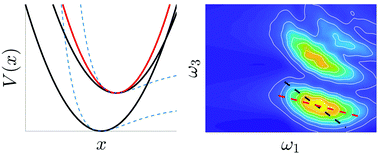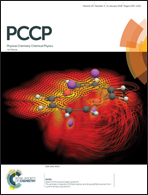Two-dimensional electronic spectroscopy of anharmonic molecular potentials†
Abstract
Two-dimensional electronic spectroscopy (2DES) is a powerful tool in the study of coupled electron–phonon dynamics, yet very little is known about how nonlinearities in the electron–phonon coupling, arising from anharmonicities in the nuclear potentials, affect the spectra. These become especially relevant when the coupling is strong. From the linear spectroscopies, anharmonicities are known to give structure to the zero-phonon line and to break mirror-symmetry between absorption and emission, but the 2D analogues of these effects have not been identified. Using a simple two-level model where the electronic states are described by (displaced) harmonic oscillators with differing curvatures or displaced Morse oscillators, we find that the zero-phonon line shape is essentially transferred to the diagonal in 2DES spectra, and that anharmonicities break a horizontal mirror-symmetry in the infinite waiting time limit. We also identify anharmonic effects that are only present in 2DES spectra: twisting of cross-peaks stemming from stimulated emission signals; and oscillation period mismatch between ground state bleach and stimulated emission (for harmonic oscillators with differing curvatures), or inherently chaotic oscillations (for Morse oscillators). Our findings will facilitate an improved understanding of 2DES spectra and aid the interpretation of signals that are more realistic than those arising from simple models.



 Please wait while we load your content...
Please wait while we load your content...